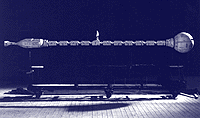Spotlight : April 1998

Spotlight : April 1998

Debert: As we know, 2001 was the first movie to realistically depict space travel
scenarios, with all the slowness of moving in zero G. Was there a lot of attention paid to
realistic physical effects in the movie?
Pederson: Absolutely. We were very concerned, for instance, about the relative motion of
things. We knew right away that we would have a lot of star backgrounds that had to
move very slowly or they would strobe. And although in real space travel the stars
would not move at all in respect to the ship, we decided to have them move a little
bit to avoid having the shots look too static. So one of the first things we did was
pretty much get a standard speed for star motion. We didn't want the stars to be too
conspicuous, because they were only there to give a sense of drift, and there wasn't
any time in which something had to move against them very fast, as far as the
spacecraft were concerned.
The modeling of all those miniatures was undertaken by the practical special effects
supervisor, Wally Veevers, who was the key man on the live action. He was a veteran
from way back on special and practical effects. A wonderful guy who's passed away now, as have others in the picture, like Geoffrey Unsworth and John Alcott (cinematography). So there are some people that have not survived these 30 years, fortunately I have managed to do it (knocking on the
table). Whether I live to see the year 2001 remains to be seen... (Laughs)
Yeah, I think we were very conscious of practical details, but they would never get
in they way of the kind of sedate beauty we were after. We always refer to it,
whenever possible, as a kind of art film. We knew it was
probably going to be tough to sell it to people, and fortunately we were far enough
"We were very conscious of practical details, but they would never get
in they way of the kind of sedate beauty we were after."
Kubrick had sold the picture to some extent on the idea of dramatic music and a
trip into the cosmos, and what that trip was going to be was not too clear.
Originally there was going to be a black & white opening on a small screen, kind of a
historical Cinerama opening with a bunch of scientists like Carl Sagan and so on.
That intro was actually shot and that was going to be the way it was introduced to the
people as to make it a little more palatable for the average audience. However, as the things progressed, that intro was thrown out. The narrator, a Canadian
named Douglas Rein, ended up being the voice of HAL.
Debert: Who actually recorded all the voice sections not knowing exactly how they were
going to be used.
Pederson: In fact, related to the Discovery sequence, I remember working on Sundays for
quite some time. There was in Stanley's office a storyboard probably 15 feet across,
which we kept looking at quite late in the game, trying to work out the story itself:
We knew what the story was like, but there were a lot of little details to be worked
out, and it was fun because we embedded some things that were almost a spur of the
moment. For instance, the HAL lip reading sequence. That came right away and it would
be the typical thing that Stanley would come up with. He would come in the morning
with some idea and he would say "...so, what do you think of this?", and he would
relate it and we would say "...that's great Stanley...", and the fact is that it was,
and we would always solve the problems.
Arthur Clarke at that point was kind of running on the side of the wagon. After the
first year he had gone back to Ceylon (now Sri Lanka), to Colombo where he still lives,
and he would put in an occasional appearance when he was on tour. He would come by to
see what was happening. He would come and talk to Stanley because he was working on
the book, and it would be a classical example of long distance creativity. I remember
once when he came by, he was on a literary tour, and he said "...well, I've got to
finish the book, I've got to finish the book, so are we going to Jupiter or Saturn?!", and I said "...well Arthur, we have talked about that, and Stanley asked me what I thought was best. I knew that Saturn was twice as far as Jupiter and it has rings on it, and we don't know how to do those rings...". So Stanley said, "Let's go to Jupiter."
from Culver City that MGM didn't really get a good grip on the plot to pull out
anything in time. Bob O'Brian, the president of MGM, had come to London to see what
was going on and to justify getting more money when we started running over budget.
Stanley needed to convince him that although it was taking longer that expected, it
was going to be worth it.
the business between HAL and the two astronauts and what was going to happen, and the
logistics of that. We didn't do that until very close to the end of that particular
shooting.


The 11' model of the Discovery during photography, and how the model appears in the film.
END OF PART ONE
Back to the Spotlight Main Menu

. . VFX HQ Produced by Todd Vaziri . . http://www.vfxhq.com . . e-mail: tvaziri@gmail.com . .
All text Copyright © 1998 Todd Vaziri, unless otherwise noted